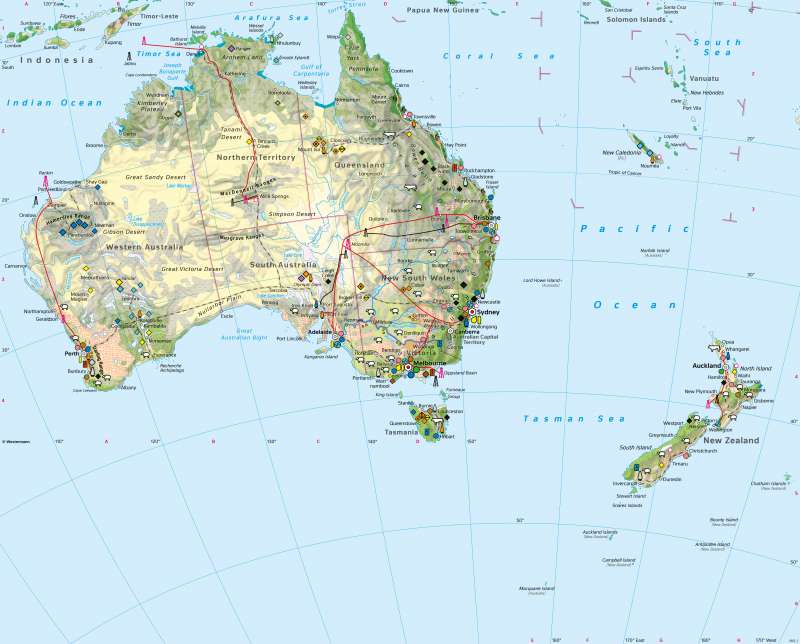Australia and New Zealand - Economy and land use
Economy and land use
978-3-14-100890-6 | Page 164 | Ill. 1

Overview
Australia's agricultural use reflects the climatic conditions of the continent. The densely forested mountainous areas in the southeast are followed in a semicircle by a zone of intensive livestock farming, which merges into a wheat belt and finally into a zone of extensive sheep farming. Large areas of the arid regions can only be farmed because groundwater is available in the form of artesian wells. The coastal areas, as long as they receive sufficient rainfall, are favourable areas for settlement and agriculture. Tropical plantation products thrive on the Queensland coast, and fruit and wine-growing is practiced on the south-east coast. Numerous irrigation projects attempt to mitigate the drought risk to agriculture. Beef, wheat, and wool continue to form the backbone of Australian agriculture. Australian agricultural products are competitive on the world market.
Structure of the Australian economy
The Australian economy is characterised by a high importance of primary goods. Mining products, agricultural products and food account for about 70 percent of exports. The traditional orientation of trade flows towards Europe has recently been replaced by a stronger turn towards Asia. Australia is one of the most important suppliers of raw materials for these countries. The most important exports are coal - Australia has been the world leader in hard coal since the mid-1980s - iron ore, gold, crude oil and petroleum products, and natural gas. The export of liquefied natural gas is to be greatly expanded in the coming years.
Despite its export orientation, Australia is a service economy (share of nearly 80 percent of GDP). The megacities of Perth, Adelaide, Melbourne, Sydney, and Brisbane, where about two-thirds of all Australians live, are not only control centres of the domestic economy, but also hubs of international economic relations. The most important individual sectors of the service sector are finance, real estate and business services. In addition, future-oriented industries such as information and communication technology, e-commerce as well as bio-, nano- and medical technology are playing an increasingly important role.
Tourism is of great economic importance. Whereas in 2000 a good 4.9 million international arrivals were registered, in 2019 this figure had already risen to 9.4 million. A significant share of the growth in the tourism sector is accounted for by young people who discover the continent for themselves in a combination of work and travel ("work & travel"). This form of travel was made possible by international agreements on simplified residence permits ("working holiday visas") from 2000 onwards.
New Zealand and ist economy
The geographical location of New Zealand is comparable to Europe in terms of climate. The South Island is shaped by the New Zealand Alps. The location in the west wind zone leads to high precipitation on the west coast, which is densely forested and inaccessible. The grasslands of the eastern foothills, characterised by the leeward location, are used for extensive sheep grazing, which changes to fattening sheep and wheat cultivation on the Canterbury Plain. The North Island is also characterised by intensive dairy and lamb farming. New Zealand is a leading exporter of dairy products, mutton, beef, and fruit. The world's largest planted forests are becoming increasingly important in timber and pulp production. Large hydropower reserves, natural gas deposits, geothermal energy sources and coal lead to a favourable energy supply situation. This is why the aluminium industry was able to settle on the south coast near Invercargill, and the iron industry is important on the Northern Island. Additional mineral resources include gold. Furthermore, the food industry is represented at several locations on both islands.
Tourism is an important economic sector for New Zealand. While New Zealand was long considered an Eldorado for backpackers and adventure tourists, for some time now the tourism board has been making greater efforts to attract holidaymakers with higher travel budgets. There are now more than 160 five-star hotels in the country.




